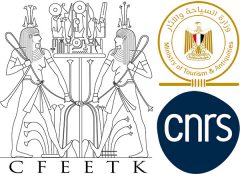Le CFEETK est heureux d’annoncer l’appel à contribution pour les Cahiers de Karnak 18. La date limite d’envoi des articles est fixée au 30 avril 2024 (pour une publication en 2025). Pour participer à ce numero, un accord de principe est demandé dès que possible (à jeremy.hourdin@cnrs.fr).
The CFEETK is pleased to announce that the table of contents of Cahiers de Karnak 18 is now opened. The deadline for submitting a paper is fixed to April 30th 2024. To participate to this volume, a response is requested as soon as possible (to jeremy.hourdin@cnrs.fr).
EDIT (september 2024): New deadline 31 December 2024
Normes éditoriales et bibliographiques :
Editorial and bibliographical guidelines
— Les articles peuvent être rédigés en français, en anglais ou en allemand. Un abstract en anglais devra être donné par l’auteur (300 mots maximum) qui sera traduit en arabe.
Articles can be proposed in French, English or German. An English abstract (maximum 300 words), which will be translated into Arabic, should be provided by the author.
— Respecter les normes éditoriales de l’Ifao (lien).
Please follow the editorial guidelines of the Ifao.
— Chaque article accepté par le comité éditorial pourra aussi faire l’objet d’un peer-review.
All the articles accepted by the editorial committee may also be peer-reviewed.
— Illustrations : utiliser de préférence le format TIFF (300 dpi minimum) ; plan et facs-similés : envoyer de préférence les versions Adobe Illustrator (ou d’autres logiciels).
Illustrations should ideally be supplied in TIFF format (300 dpi minimum); plans and drawings : please provide Adobe Illustrator (or other drawing application) files.
— Pour la bibliographie / bibliography :
- Dans les notes de bas de page (et dans le corps du texte), utiliser une version abrégée de la référence (exemples ci-dessous) / In footnotes and in text, rather use an abbreviated version of the reference (exemple hereunder).
- Fournir une bibliographie complète en fin d’article : suivre les normes bibliographiques de l’Ifao (lien) / liste des abréviations / Provide a complete bibliography at the end of the article, following the guidelines of the IFAO.
- Ne pas utiliser op. cit., ibid., etc. / Avoid using op. cit., ibid., etc.
Exemples :
Notes de bas de page & bibliographie / footnotes and bibliography :
— Paper in English (use “…”, in, etc.):
A. Al-Taher, “A Ptolemaic Graffito”, Karnak 16, 2017, p. 15.
= A. Al-Taher, “A Ptolemaic Graffito from the Court of the 3rd Pylon at Karnak”, Cahiers de Karnak 16, 2017, pp. 13-26.
A. Fawzy Ali, “Evidence for the Cult of Osiris at Karnak”, in Current Research in Egyptology 2022, 2023, pp. 171-182.
= A. Fawzy Ali, “Evidence for the Cult of Osiris at Karnak during the Greco-Roman Period: The Excavations in front of the 1st Pylon”, in A. Bouhafs, L. Chapon, M. Claude, M. Danilova, L. Dautais, N. Fathy, A.I. Fernández Pichel, M. Guigner, M. Pinon, M. Valerio (eds.), Current Research in Egyptology 2022, CENiM 36, Montpellier, 2023, pp. 171-182.
— Article en français (utiliser « … », dans, etc.) :
M. Broze, R. Preys, La porte d’Amon, 2021, p. 30-32, pl. 6.
= M. Broze, R. Preys, La porte d’Amon. Le deuxième pylône de Karnak I. Études et relevé épigraphique (Ka2Pyln nos 1-33), TravCFEETK, BiGen 63, Le Caire, 2021.
À propos des / About Cahiers de Karnak
Les Cahiers de Karnak regroupent depuis plus de 50 ans des articles sur les travaux du CFEETK au sein de l’enceinte de Karnak. Ils accueillent également des publications de chercheurs (égyptiens, français et internationaux) relatives à l’étude de l’histoire de ce site et de ses environs, de ses monuments ou encore des cultes des nombreuses divinités thébaines.
The Cahiers de Karnak gather since 50 years papers dealing with the work carried on inside the precinct of Amun at Karnak by the CFEETK. The journal also welcomes contributions of scholars (of all nationalities) dealing with the researches on the history of the site and its near surroundings, with its monuments or with the numerous theban deities.
Comité éditorial : Ahmed Al-Taher, Jérémy Hourdin

